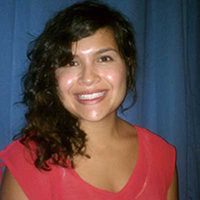Alicia Inez Guzmán
Greenleaf Visiting Library Scholar
PhD Student
University of Rochester, New York

Alicia Inez Guzmán received a Greenleaf Visiting Library Award in Summer 2012 to support research on From Place to Property: Landscape/Land Tenure in New Mexico. At the time of the award, she was a doctoral student in the Visual and Cultural Studies Program at the University of Rochester, New York.
Originally from Truchas, NM, Guzmán is a freelance writer and contributing faculty member at Santa Fe University of Art and Design whose work focuses on mestizo and indigenous land based art and histories of land use.
Title of Research : From Place to Property: Landscape/Land Tenure in New Mexico
While at UNM, Guzmán drew upon library archives to examine the historical period between 1892 and 1896, when the Surveyor General completed a plat map of the Town of Abiquiu grant and its landmarks for the Court of Private Land Claims. It pictures a latticework of twenty-seven, nearly identical squares punctuated by landmarks and place names. Only a few decades after its completion, Georgia O'Keeffe began painting in New Mexico, creating her characteristic landscapes of animal bones scattered along unmarked, flesh tone expanses. For this talk, I offer two visions of a single though multiply signifiable landscape to consider the unsettling space between painting and cartography with regard to place and people. A politically and socially precarious time, New Mexico's transition from territory to statehood and the years to follow triggered a particularly precarious set of representations across media, whose reverberations are felt throughout the twentieth century. I will thus forge a dialogue between a complex history of Hispanic and Native land tenure and its representation and a mostly Euro-American aesthetic tradition of landscape painting that pictures New Mexico as "immutable, monumental almost to incomprehensibility." In the face of such an aesthetic imagination that visualizes New Mexico as boundless, timeless and beyond intelligibility, I offer a new landscape paradigm, one that calls for an examination of the visual, spatial and extralegal dimensions of these turn-of-the-century plat maps. The ground of the cartographic page, as I will argue, acts as an archive of the past--albeit laconic and sometimes troubling--nonetheless recording not the immutability or emptiness of the New Mexican landscape, as landscape paintings often suggest, but shifts in internal borders through time. To reflect on these collaborative documents visually then is to begin to understand the power that resides between image, image-maker(s) and space. It is to understand, furthermore, the relationship between acts of representation and (dis)possession.
